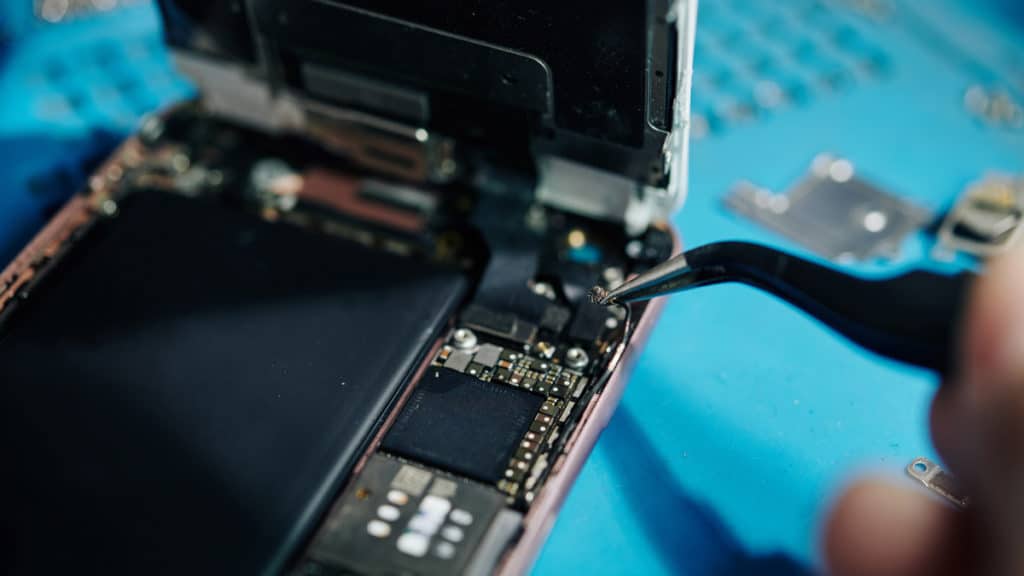Article explains basic configurations of smartphone antennas and application/requirements of capacitors used in these systems.
Antennas are fundamental components in today’s communication devices. They are used for transmitting and/or receiving signals in form of electromagnetic waves, and come in a variety of designs, shapes and sizes depending on the applications for which they are intended.
Capacitors have a broad range of applications in modern antenna systems. In this article, we will explore the applications of capacitors in smartphone antenna systems and key considerations when selecting these components.
Smartphone antenna systems
A typical smartphone employs multiple antenna systems: cellular communication antenna system, BlueTooth antenna system, GPS antenna system and WiFi antenna system.
In addition to the different systems, some antenna systems contain more than one antenna. For instance, a typical 4G LTE antenna system contains two or four antennas.
Having antennas close to each other in a limited space, as is common in mobile devices, poses challenges to circuit designers.
Mobile devices such as smartphones and tablets require antennas that are small in size and capable of delivering excellent performance. In addition, these antenna systems demand capacitors with specific performance characteristics.
In a typical smartphone, we can have two or more antenna systems working simultaneously. The distance between these antenna systems is usually small making it extremely difficult to achieve flawless performance.
Mutual interference can greatly affect the performance of a device and it is critical for circuit designers to minimize it. As more features are being added to mobile devices and the need for more antennas grows, traditional techniques of preventing mutual interference are becoming less and less effective.
Designers use various techniques to eliminate or minimize interference between antenna systems. Some of the strategies that are commonly used include distributing the antennas, minimizing the size of antennas, using band pass filters and employing more directional antennas.
The mutual interference between antennas is greatly determined by how they are placed within a device. To minimize it, most manufacturers distribute antennas in a way that ensures minimum interference. The downside of this approach is that the user may unknowingly block some of the antennas when holding a device leading to poor performance.
Another approach is using multiple directional antennas. The antenna that receives the strongest signal is selected. Although this approach is commonly used in portable devices, its use in smartphones is limited due to the compactness of today’s devices.
The interference between a pair of antennas that are oriented in the same direction is more than the interference between a pair that is not oriented in the same direction. Placing antennas in a way that produces different polarization profiles helps to minimize interference between different antenna systems in a smartphone. This strategy is less effective for devices with multiple antenna systems such as today’s smartphones.
There is not a single strategy that completely eliminates mutual interference in antenna systems. However, by combining two or more strategies, it has been demonstrated that the interference can be reduced to acceptable levels. This is the approach that most smartphone manufacturers are using to ensure that multiple antenna systems work in compact devices with minimum impact on performance.
Applications of capacitors in smartphone antenna systems
Capacitors are key components in antenna systems. The most common applications of capacitors in antenna systems include impedance matching, frequency tuning and filtering.
Antenna tuning is one of the strategies used by smartphone manufacturers to improve the overall efficiency of smartphone antenna systems. Tuning an antenna helps to improve its range and radiated power. Aperture tuning boosts the total antenna efficiency while impedance tuning maximizes the power transferred by an antenna.
Capacitors and inductors are commonly used for tuning applications. Adding these components to antenna systems also helps to adjust the resonant frequency. Capacitors for use in today’s smartphone antenna systems are required to have excellent performance characteristics.
Apart from tuning, capacitors are also used in smartphone antenna systems for filtering and impedance matching. In general, these capacitors are required to have low leakage current, high quality factor, high power capability and high linearity. For instance, tunable capacitors for use in antenna systems are designed to offer excellent RF performance, high linearity, and low power consumption.
The power transferred by an antenna is greatly affected by impedance mismatch. Matching the impedance helps to boost the efficiency with which an antenna transfers power. Dynamic matching of the impedance further improves the efficiency since the component is capable of determining the addition or subtraction required to achieve a matched system.
Advancements in capacitor manufacturing technology
Various advancements in capacitor technology have been made in an attempt to produce capacitors that meet the strict performance requirements of smartphone antenna systems. To start with, capacitor manufacturers are using microelectromechanical systems (MEMS) technology to produce ultra-small capacitors for smartphone antenna systems.
Unlike ordinary capacitors, these components offer improved impedance matching. In addition, this technology enables smartphone manufacturers to get components with close tolerance capacitance values.
MEMS technology also allows production of tunable capacitors that are ultra-small in size. Since space limitation is a major challenge in today’s smartphones, the small size of these components makes them an unmatched option. In addition, capacitors that are based on this technology provide dynamic impedance matching thus lowering the overall power consumption.
Thin-film technology is commonly employed in the manufacturing of capacitors for use in smartphone antenna systems. This technology enables production of components with performance characteristics that can be tightly controlled. Using thin-film capacitors improves the overall efficiency of smartphone antenna systems.
Conclusion
Today’s smartphones have multiple antenna systems crammed within a compact space. Smartphone manufacturers are employing different strategies to minimize mutual interference between different antenna systems. Capacitors are fundamental components in today’s smartphone antenna systems. They are mainly used for filtering, frequency tuning, and impedance matching. Capacitors for use in these applications are required to have excellent performance characteristics including low leakage current, high quality factor and high linearity.
